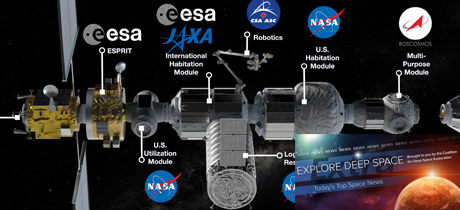In Today’s Deep Space Extra… NASA’s Nick Hague eager for a second launch attempt to the International Space Station (ISS) on Thursday. NASA finds global interest in a human tended, lunar orbiting Gateway space station. Toyota has joined with the Japanese Aerospace Exploration Agency (JAXA) to develop a lunar rover for astronauts. Samples of the Moon gathered by Apollo astronauts will get a second look.
Human Space Exploration
NASA astronaut Nick Hague calls Russia’s Soyuz rocket ‘technical marvel’
TASS of Russia (3/12): NASA astronaut Nick Hague expressed confidence in Russia’s Soyuz, the world’s only spacecraft currently capable of transporting astronauts to and from Earth orbit. Hague, fellow NASA astronaut Christina Koch and cosmonaut Alexey Ovchin are to board the Soyuz MS-12 late Thursday afternoon to launch to the International Space Station (ISS) for a six month stay. On October 11, the Soyuz MS-10 with Hague and Ovchinin aborted its launch two minutes after lifting off from the Baikonur Cosmodrome in Kazakhstan. The spacecraft landed safely with the two men.
Budget proposal, ISS partners provide new momentum for lunar Gateway
SpaceNews.com (3/12): NASA’s proposed human tended lunar orbiting Gateway fared well in the White House NASA budget proposal for 2020 earlier this week. NASA’s International Space Station (ISS) partners are also voicing an eagerness to participate in the development. Assembly could begin in 2022, with enough of the assembly complete by 2024 to house human crews. Four years later, human explorers dispatched from the Gateway would once again stroll on the lunar surface.
Japan wants to put a Toyota on the Moon
Bloomberg (3/12): The major automaker Toyota and the Japan Aerospace Exploration Agency (JAXA) have agreed to accelerate development of a large six wheeled super van that could house a pair of astronauts in a pressurized environment as they drive across the Moon for up to 10,000 kilometers, or 6,200 miles. Their goal is to have a lunar model available in a decade.
Space Science
Op-ed | The rocky landscape for astrophysics
SpaceNews.com (3/12): NASA’s 2020 budget proposal for a second year includes cancellation of the Wide Field Infrared Space Telescope (WFIRST), which like the James Webb Space Telescope (JWST) is a successor to the Hubble Space Telescope. WFIRST carries a high priority with the National Academies of Science, Engineering and Medicine. After a mid-2020’s launch, WFIRST would study dark energy and probe distant extra solar planets for evidence of habitable environments. Congress warded off cancellation efforts in 2019 with a $312 million appropriation. Efforts to cancel WFIRST amount to a repudiation of the astrophysics community’s efforts to back U.S. leadership in the field, writes Jon Morse, a former director of astrophysics at NASA.
Water hops all around the Moon over the course of a lunar day
Space.com (3/11): NASA’s proposed 2020 budget places a focus on a sustained human return to the Moon as a proving ground for the eventual human exploration of Mars and other deep space destinations. New studies using NASA’s Lunar Reconnaissance Orbiter (LRO), which has been circling the Moon since 2009, follows the migration of water on the Moon as the surface warms and cools. Water is viewed as a resource for future human exploration. In addition to providing a consumable liquid and source of oxygen, water ice could be mined and processed into liquid hydrogen and oxygen rocket fuels.
NASA will finally unseal and study 3 lunar samples that have sat intact for nearly 50 years
Orlando Sentinel (3/12): Earlier this week, NASA announced that it will assign pristine samples of the Moon collected by Apollo astronauts to researchers for study using advanced technologies. Among the questions they expect to address assessing samples gathered by the Apollo 15, 16 and 17 astronauts include lunar soil water content and interactions with the lunar environment, evidence of organics and the effect of meteorite impacts on the surface.
Other News
DOT requests big boost for commercial space transportation in FY2020
Spacepolicyonline.com (3/11): Department of Transportation commercial space budget support would rise from $36.5 million in 2019 to $64.6 million in 2020 under the White House 2020 budget proposal submitted to Congress earlier this week. The rise, if Congress agrees, would help to integrate commercial space activities into the nation’s airspace.
DOD wants 17 percent increase for space activities in FY 2020
Spacepolicyonline.com (3/12): The 2020 Pentagon space budget request presented by the White House to Congress on Monday totals $14.1 billion. Of that, $72.4 million would be invested in standing up a new branch of the military, the Space Force, and a provisional headquarters within the U.S. Air Force. Spending on the Space Force would ramp up to an estimated $500 million annually.
Houston pitched for possible Space Force headquarters
KHOU-TV of Houston (3/11): Texas Gov. Greg Abbott is offering Houston’s Ellington Airport as a site for a Space Force headquarters. Space Force is a new branch of the U.S. military that is proposed initially to be part of the U.S. Air Force. Ellington is licensed as a horizontal spaceport as well as home to units of the U.S. Coast Guard, Texas Air National Guard and aircraft operated by NASA’s Johnson Space Center (JSC).
Nuclear rockets could open up solar system and help settle space, and NASA is interested
USA Today (3/11): Might nuclear rockets, a concept explored by NASA in the 1960’s and others after World War II, return with the promise of reducing the travel time to Mars to four months?

